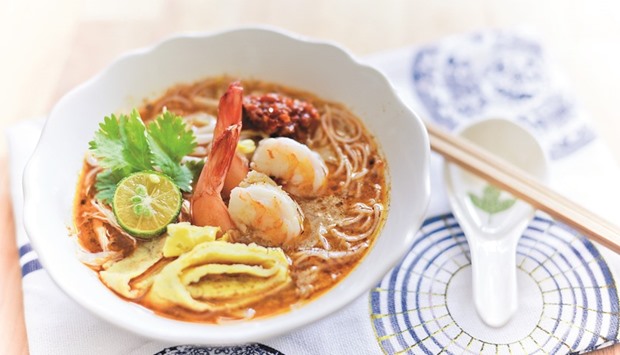Laksa is a popular spicy noodle soup from the Peranakan culture, which is a merger of Chinese and Malay elements found in Malaysia, Singapore and Indonesia.
The origin of this name “Laksa” is unclear. One theory traces it back to Hindi word “lakhshah”, referring to a type of vermicelli, which, in turn, may be derived from the Sanskrit “Lakhsas’’ meaning one hundred thousand. It has also been suggested that “Laksa” may have been derived from Chinese word meaning spicy sand due to the ground dried shrimps which give a sandy texture to the sauce.
During my visit to Singapore few years ago, I came across the diversity of Singaporean cuisine and how the Singaporean street food can compete with some of the best foods available in that part of the world. The street food markets are well organised and so popular that they are always bustling with people throughout the day.
There are various types of Laksa in Singapore – from Penang Laksa to the curry-like Sarawak Laksa. But the most popular one is the home-grown Katong Laksa.
Katong Laksa is inspired by the Peranakans (Chinese immigrants who settled in the British Malay colony now known as Singapore and Malaysia) who live in Katong area. It has a spicy soup stock the colour of a flaming sunset, flavoured with coconut milk and dried shrimp, and topped with ingredients like cockles (a type of mollusc), shrimp and fishcakes.
My favourite part and the main characteristic aspect of this dish is the noodles, thick vermicelli cut into shorter pieces which can be spurred with a spoon. Unlike the other Singaporean dishes you need a spoon not a chopstick for this delicacy.
The taste knows no boundary and thus this popular dish has crossed all boundaries and has travelled in all directions and every corner of Singapore, due to franchising and enterprising Laksa stalls all across Singapore. Like what happens with all popular dishes, every food enterprise claims to be the original and most authentic one, the same is the case with this Laksa, every stall in Katong claims to be the original.
Portion sizes for Laksa curry varies, although it’s served in a bowl and most vendors prefer the smaller bowls because the broth is considered precious and there are so many ingredients and steps involved in it so to make sure people treasure it and finish it. To summarise, you can call it a perfect blend of smooth coconut milk, flavourful and spiced-up broth.
Laksa
Ingredients
(Serves 2)
Shrimps, 21/30 400gm
Fish cakes 200gm
Dried red chilli 10-12 no
Candlenut/ macadamia, cashew nut 8no
Galangal 1 knob
Lemongrass 2 stalks
Coriander seeds 1 tsp
Fresh turmeric knob 1 no
Salt to taste
Canola oil 1 cup
Dried shrimp 50gm
Water 750ml
Coconut milk 750ml
Laksa leaves, minced 4tbsp
Fish stock as required
Firm tofu 60gm
Bean sprouts 60gm
Garnish
Green chilli chopped 1tsp
Cilantro leaves, chopped 2 tbsp
Sambal chilli 1tbsp
Laksa leaves, chopped 1/2 tbsp
Method
Combine the chillies, shallots, candlenut, galangal, ginger, lemon grass, coriander seeds, turmeric, salt in a mortar and pestle and found to a smooth paste or use a food processor with some oil to make it to a paste
Heat the oil in a large pan and add the pasta, stir continuously over a low heat until fragrant (about 30 minutes).
Add dried shrimp powder, and stir for about 5 minutes and add water and simmer for 30 minutes.
Add half of coconut milk, slowly and stir continuously.
Stir in laksa leaves and then the remaining coconut milk, stirring continuously.
Add the dried shrimp powder, stirring for about 5 minutes, then add water and simmer for another 30 minutes.
The broth should be thick but still soupy.
Add fish stock or water to thin as required.
Add fish cake and shrimp and simmer for 3-5 minutes.
Adjust the seasoning with salt and sugar as required
In a separate pot, cook the half-broken rice noodles, drain and keep aside.
Fry the slices of tofu in oil until golden in colour, season with salt and keep aside.
To serve, divide the noodle and bean sprouts among four soup bowls, fill each with broth, then top with even portions of fish cakes, shrimps and tofu.
Garnish with Laksa leaf, fresh cilantro leaves, samba and chilli.
Note
Candlenut is a nut similar to academia nut and cashew nut. It has a wax like oily texture similar to the other nuts. You can make this recipe without Laksa leaf. You can look through the Asian/ Japanese ails in hypermarkets to get this leaf. You can replace fish cake with fish fillet if you are unable to source it.
* Chef Tarun Kapoor,
Culinary Mastermind, USA. He may be contacted at [email protected]



